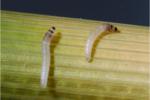Common name
Scientific name
The following stemborer species infest rice: yellow stem borer (YSB), Scirpophaga incertulas; white stem borer (WSB), S. innotata; striped stem borer (SSB), Chilo suppressalis; Gold-fringed stem borer, C. auricilius; Dark-headed stem borer, C. polychrysus; and, Pink stem borer, Sesamia inferens
What it does
Stem borers can destroy rice at any stage of the plant from seedling to maturity.
They feed upon tillers and causes deadheart or drying of the central tiller, during vegetative stage; and causes whiteheads at reproductive stage.
Why and where it occurs
The yellow stem borer is a pest of deepwater rice. It is found in aquatic environments where there is continuous flooding. Second instar larvae enclose themselves in body leaf wrappings to make tubes and detach themselves from the leaf and falls onto the water surface. They attach themselves to the tiller and bore into the stem.
Striped stem borer is most abundant in temperate countries and in non-flooded areas. Their final instars remain dormant in temperate areas during winter.
The pink stem borer is found in upland rice, which is grown near sugarcane or related grasses. The presence of alternate hosts encourages the pink stem borer to develop, multiply and survive during winter or dry season. Unlike other species of stemborers, the pink Stem borer have bare eggs laid between the leaf sheath and the stem.
High nitrogenous field favors population buildup of the stem borers. Fields planted later favors more damage by the insect pest that have built up in fields that have been planted earlier. Stubble that remains in the field can harbor stem borer larvae and or pupae.
How to identify
Check the field for the following damage symptoms:
- Deadhearts or dead tiller that can be easily pulled from the base during the vegetative stages
- Whiteheads during reproductive stage where the emerging panicles are whitish and unfilled or empty
- Tiny holes on the stems and tillers
- Frass or fecal matters inside the damaged stems
Deadhearts and whiteheads symptoms may sometimes be confused with damages caused by rats, neck blast, and black bug diseases.
To confirm stem borer damage, visually inspect rice crop for deadhearts in the vegetative stages and whiteheads in reproductive stages. Stems can be pulled and dissected for larvae and pupae for confirmation of stem borer damage.
Click on images to enlarge
How to manage
- Use resistant varieties
- At seedbed and transplanting, handpick and destroy egg masses
- Raise level of irrigation water periodically to submerge the eggs deposited on the lower parts of the plant
- Before transplanting, cut the leaf-top to reduce carry-over of eggs from the seedbed to the field
- Ensure proper timing of planting and synchronous planting, harvest crops at ground level to remove the larvae in stubble, remove stubble and volunteer rice, plow and flood the field
- Encourage biological control agents: braconid, eulophid, mymarid, scelionid, chalcid, pteromalid and trichogrammatid wasps, ants, lady beetles, staphylinid beetles, gryllid, green meadow grasshopper, and mirid, phorid and platystomatid flies, bethylid, braconid, elasmid, eulophid, eurytomid and ichneumonid wasps, carabid and lady bird beetles, chloropid fly, gerrid and pentatomid bugs, ants, and mites, earwigs, bird, asilid fly, vespid wasp, dragonflies, damselflies, and spiders
- Bacteria and fungi also infect the larvae: mermithid nematode, chalcid, elasmid and eulophid
- Apply nitrogen fertilizer in split following the recommended rate and time of application.
Learn more
View full fact sheet:
Stem borer on IRRI Rice Knowledge Bank





